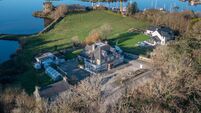Most pearl mussels are now more than 100 years old
The council is calling for a €20m plan to save wildlife under threat and generally improve our environment, which has taken a severe battering since the 1970’s — a trend that’s continuing with the economic boom.
In Ireland, over 29 different bird species and 120 species of flowering plants are in serious decline. And, amid reports of rapidly vanishing and even extinct species — now coming on an almost daily basis — fears are being expressed for the survival of our longest living animal, the pearl mussel.
Ireland is one of the last places in Europe where the pearl mussel is still found.
It can live for 120 years, but is facing extinction in all rivers surveyed where previously healthy populations of the species survived, according to the Heritage Council.
Most of the living pearl mussels are now over 100-years-old and were born before Irish Independence: the younger mussels have not survived because of deteriorating water quality caused by pollution and siltation.
These mussels can only survive in unpolluted rivers and, in 1990, were observed in just 10 to 12 rivers located in very rural areas where there was little forestry and not much use of fertilisers. The effects on our water quality and sensitive wildlife are now being seen as these areas succumb to development and forestry pressures.
The Heritage Council is calling for immediate changes to protect native species and help us meet our biodiversity targets. In short, the call is for a major new approach to how we manage our environment.
Worldwide, the human population is putting a huge strain on plant and animal species causing them to disappear at up to 50 times the natural rate.
Ireland could face hefty fines from the EU, under the Habitats Directive, unless a number of unique Irish animals, including the pearl mussel, are protected.
For more than 30 years, our environment has been damaged by unprecedented development, certain farming practices such as the overuse of nitrates, removal of native hedgerows and draining of wetland, household and industrial pollution and also some forestry practices.
Some bumblebees are also facing extinction, mainly because their habitats have altered so drastically over the past 30 years. Grasslands support an enormous variety of species, such as bumblebees, and changes in farming practice and the increasing use of pesticides is having a detrimental effect on biodiversity.
“The situation is serious because everything in nature is interconnected. When we lose one species others go into decline and eventually it will effect people. We are all part of the intricate web of nature and we must protect it for our long-term health and well-being,” said Liam Lysaght, natural heritage officer with the Heritage Council.
“We need to take a more holistic view and change the way our landscape is managed if we are to maintain a healthy environment.”
While recent changes to EU farm payments favour a more environmentally friendly approach to land use, changes need to be implemented quickly if many important habitats, on which our wildlife depends, are to survive.
The Heritage Council has recently set up a National Biological Records Centre to address a lack of information on the status of much of Ireland’s biodiversity. The centre will make essential information available to policy makers and planners and it is hoped that such information will help improve policy across departments.
“The benefits from implementing this approach will leave us with a much better environment, cleaner water to drink, it will help us meet our biodiversity targets and it will also have serious financial benefits especially for fisheries, rural development and tourism,” remarked Mr Lysaght.
Native species that have gone into extinction in Ireland over the past 30 years include the corn bunting and the Corncockle
Species under serious threat include the pearl mussel, six species of bumblebee, the barn owl, the golden plover, waxcap, marsh fritillary butterfly, green-winged orchid and the corncrake
Meanwhile, the Heritage Council has allocated almost €3m for seven grant schemes for 2007. Projects which will be considered include local heritage, biodiversity, archaeology, publications, restoration of heritage buildings and museums and archives.
Hundreds of projects have received funding over the years. Previous projects included restoration of wildlife corridors, conservation of historic buildings, railways and monuments, education and awareness raising projects, wildlife conservation, restoration of wetland and bogland and inner city projects.













